Historical Narratives of the Akonting and Banjo
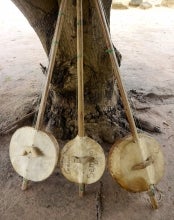
I travelled to The Gambia in the summer of 2012 to learn to play a stringed instrument called akonting, not knowing then that it would spark my current dissertation research. Played by musicians of the Jola ethnic group from the Senegambian region of West Africa, the akonting is recognized as the closest known African relative of the American banjo.[1] This essay considers the role of history in the relationship between the two instruments, including both the challenge of tracing historical documentation and the ways that historical narrative has been produced by cultural activity in Senegambia and the United States. The following brief documentary film, made during my 2012 visit, introduces the sound of the akonting as played by my teacher Musa Diatta and gives a sense of my experience of fieldwork in The Gambia.
Conflicting Histories
Gambian musician and scholar Daniel Laemouahuma Jatta gave a presentation at the 2000 Banjo Collectors' Conference that would forever change the narrative of that instrument's history. Jatta first heard the banjo in the early 1970s while studying accounting in Atlanta, Georgia. When a bluegrass tune came on the local radio station, he was immediately struck by the banjo's sonic similarities to the akonting, an instrument he had played as a young man. A friend informed him that the banjo had roots in West Africa (a fact which had by then been deliberately obscured by a century of historical white-washing), launching Jatta on a path of research tracing this historical connection.
Nearly thirty years later, Jatta presented his findings at the Banjo Collectors' Conference in Massachusetts with his longtime Swedish collaborator Ulf Jägfors. The two men proposed that the akonting and banjo shared a close historical relationship, based on a nearly identical downstroke playing style and similar organological features such as a full-spike neck and an M-shaped bridge sitting atop the animal-skin soundplane. Their claims were apparently quite controversial: some members of banjo-centered online message boards accused Jatta of fabricating the instrument and its tradition for personal renown, while others allegedly even threatened physical violence against him. Why did this presentation arouse such outrage? What deeply embedded schema did their argument contest?
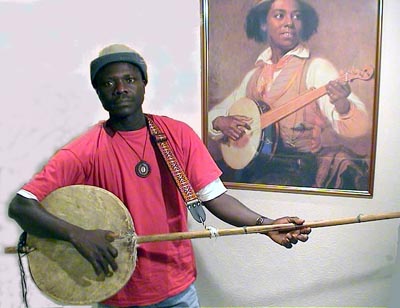
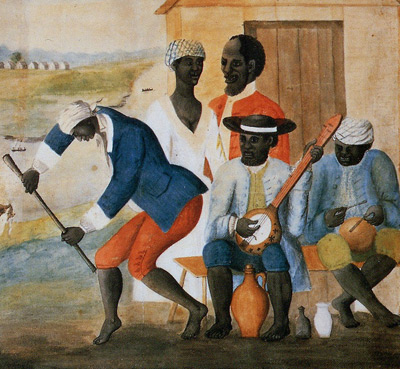
Left: Daniel Laemouahuma Jatta playing an akonting. Right: Detail from The Old Plantation, one of the earliest depictions of gourd banjos in the United States (circa 1790).
The akonting's uncanny resemblance to early American banjos challenged two central aspects of the banjo's existing historical narrative. First, it disrupted the previous consensus that American banjos descended from a group of West African archetypes played by griot musicians – plucked lutes such as the xalam, hoddu, and ngoni. While these instruments are similar to American gourd banjos in many respects, they differ in key organological details: they have wooden resonators instead of gourd resonators; they are tanged lutes rather than full-spike lutes; and their playing style involves a combination of up- and down-picking that is similar but distinct from what we know of early banjo technique. Although subtle, these differences leave room for the banjo to remain a uniquely American invention based on indeterminate African influences – and indeed the banjo's frequent sobriquet is "America's instrument." The existence of a single, specific relative containing nearly all the key features of American gourd banjos displaces the site of invention from the New World to West Africa.[2] Secondly, the emergence of the akonting contradicts the narrative of Western scholarly omniscience. Initial skepticism about the akonting's authenticity likely stemmed from a belief that such an instrument could not have escaped notice by Western scholars in this information-rich day and age. While excellent scholarship by Charry (1996), Coolen (1984), Epstein, (1975) and others has catalogued a large number plucked lutes in West Africa, the vast human diversity of that region has clearly left gaps in the Western musical ethnologue, of which the akonting's recent "discovery" is but one example.
A third reason for incredulity about the akonting is the sheer extent of its similarity to early American gourd banjos. Several essays have detailed these similarities thoroughly and systematically, so I will not dwell on them here (cf. Adams and Pestcoe 2007; Adams and Sedgwick 2007a and 2007b; Adams and Levy forthcoming; Bamber n.d.; Jagfors 2003; Levy 2012; Pestcoe n.d.). Suffice it to say, however, that the retention of construction details and especially the characteristic downstroke playing style through centuries that saw the cultural genocide of slavery and the explosion of industrial banjo manufacturing is a remarkable testimony both to the durability of musical practices and their ability to adapt to new contexts. The following videos of my akonting teacher Musa Diatta performing some of his favorite songs in The Gambia briefly illustrate the distinctive playing technique and the repeating vocal stanzas of akonting songs.
Musa Diatta plays "Mande Waruna"
Musa Diatta plays Corie Beju Dakaram
History of the Akonting
In the fourteen years since Jatta and Jägfors' presentation, any lingering skepticism about the akonting among American folk musicians has been replaced by enthusiastic acceptance of the instrument as the "ancestor" or "grandfather" of the banjo. While the evidence linking the two contemporary instruments is strong, the specific nature of their relationship rests on a murky historical conjecture: namely, that akontings were commonly played 400 years ago, during the time when millions of Senegambians were enslaved and transported to what is now the United States. Oral histories of Jola people suggest that the akonting tradition dates back at least three generations, and it is considered a very old instrument. However, since the Jola culture does not have the well-defined role of musician and oral historian played by griots, Jola oral history tends to be less formalized than other Sahelian societies and therefore does not reach into the distant past. Documentary evidence of the akonting by Western scholars dates to at least 1959, when the French anthropologist Louis-Vincent Thomas noted that "the most common and also the most famous of the chordophones [played by Jola people] is the kõtin or kõkin [i.e., akonting], which no sufficiently skilled young man misses playing" (Thomas 1959:382).[3] Neither Irvine and Sapir's 1976 article on musical style and social change among the Kujamaat Diola, nor Mark's 1994 analysis of a Jola music festival, nor Charry's 1996 survey of plucked lutes in West Africa mentions the akonting,[4] perhaps indicating the instrument had become less common or simply that those scholars did not visit areas where it remained in use. I will continue to conduct oral histories and scour university archives for further evidence of the akonting's history during my next visit to Senegambia, but for now the historical record remains rather limited.
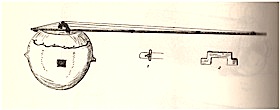
Earliest known sketch of an akonting, with details of string fixture and bridge shape. The neck appears to sit atop the soundplane with an uncertain method of securing it to the resonator, representing either a different construction method from contemporary akontings or a graphic error by Thomas. From Thomas 1959: Planche XXVL.
Tracing the akonting's history is further complicated by the historical complexities of the Senegambian region and the Jola ethnicity in particular. For centuries, everyday life in the Senegambian region has been profoundly influenced by far-reaching cultural networks, such as the intertwined spheres of Islam, colonialism, and capitalism. (Some of these influences are represented in the brief opening images of the film by the ubiquitous squawking radios and billboards advertising special rates for Hajj savings accounts and international cellphone providers offering a chance to win a free trip to Mecca.) Senegambian traditions that many consider quintessentially West African – such as drinking strongly concentrated ataaya green tea or dying brightly colored batik fabrics – are in fact legacies of colonial connections to East Asia via European powers. As Amselle (1998), Ranger (1983), and others have famously argued, the very nature of the distinct ethnic groups of contemporary Africa may also be intertwined with histories of colonialism. Indeed, Mark has argued that the sense of widespread Jola ethnic solidarity emerged in response to French colonialism and Mandinka expansion in the 1800s, and continues to sustain itself through shared customs and geography along with the fraught post-colonial political situation (Mark 1985; 1992).[5] While it is tempting to project contemporary African traditions into the distant past, as some Jola musicians do for the akonting, it is difficult to gauge the historical effects of multiple turbulent centuries on contemporary practices. As Senegambian historian Donald Wright concludes:
Anthropologists have done historians of Africa great service with their cultural studies, but often they have lent confusion to historical study by the reference to societies in the cultural present, treating them as if they never had different ways of doing things until fairly recent times [...]. In such studies, there is an implied sense that only the complex world of the twentieth century brought change to "traditional ways." Of course, this is not historical, not an appropriate way to consider cultures through time. As all people in all cultures, African societies changed. The difficulty is that for most of those societies there is not sufficient evidence of the way things used to be. (2004:45)
Producing Historical Narrative
Despite the difficulties in tracing the history of the akonting, it is undeniably a close relative of the American banjo – and this historical narrative has been mobilized through cultural activity on both sides of the Atlantic. Embraced by roots music enthusiasts in the United States, akontings are now available for purchase from well-known American banjo suppliers such as Elderly Instruments and from respected banjo builders such as Jeff Menzies and Bob Thornburg, and even from at least one folk instrument store in Argentina. The Ships of the Sea museum in Savannah, Georgia held an Akonting/Banjo Weekend in 2007, where attendees learned how to build an "a-can-ting" using a cookie tin or coffee can. Perhaps a dozen banjo players have visited The Gambia to learn from source musicians there, among them Rhiannon Giddens of the Grammy-winning Carolina Chocolate Drops and ethnomusicologist Greg Adams. Florida-based banjoist and researcher Chuck Levy designed and commissioned an instrument he calls the "banjonting," which combines elements of the banjo and akonting, and he also released an album of old time Appalachian fiddle tunes that includes four traditional Jola songs played on fiddle and akonting, sonically linking the two genres.
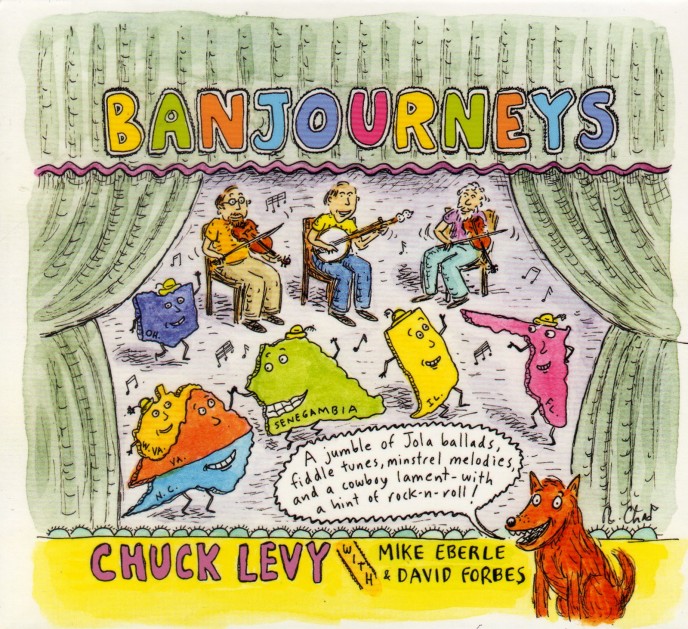
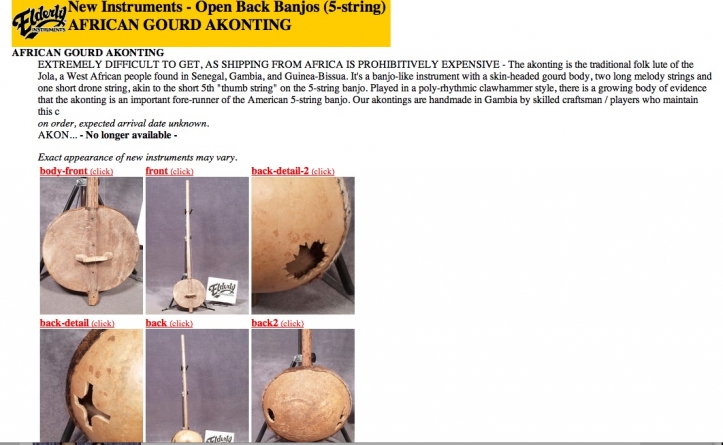
Left: Cover art for Banjo Journeys, album recorded by Florida-based banjoist and researcher Chuck Levy. Note that a smiling Senegambia is depicted dancing with several American states. Right: An akonting for sale at Elderly.com, a major folk instrument retailer.
Meanwhile, in Senegambia, the akonting is experiencing a parallel revival. Since 2005, Daniel Jatta has been working to establish the Akonting Center for Senegambian Folk Music in his hometown of Mandinari. Having recently moved permanently back to The Gambia from his previous residence in Sweden, Jatta is currently working with his cousins Remi, Ekona, and Musa Jatta to develop a curriculum and DVD series that teaches students how to play akonting and includes introductory tutorials to the Jola language. Jatta has donated akontings to the national museum in Banjul, the capital city, and earlier this year spoke at a nationally sponsored event in The Gambia officially recognizing the akonting as the "grandfather" of the banjo.
Other Jola musicians have taken the akonting in different directions. Sana Ndiaye plays a custom-made akonting with the interethnic hip hop group Gokh-Bi System (meaning "The Neighborhood System"). He describes their sound as a fusion of "'Ancient' African traditional rhythms with contemporary 'urban' American beats in a style [...] dubbed, Ancient Meets Urban" (www.gokhbisystem.com/). Ndiaye describes the akonting as "an ancient and extremely rare three-stringed gourd instrument (which looks like a large banjo) that is virtually extinct in Senegal. It is a distinctive component of our authentic sound."
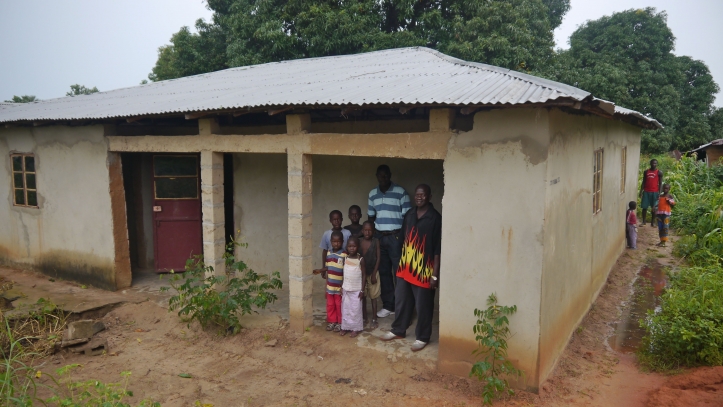
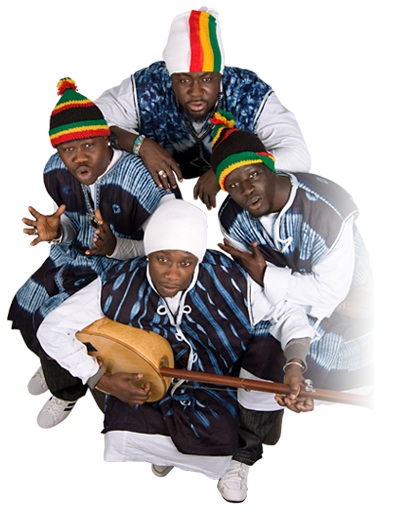
Left: The Akonting Center for Senegambia Folk Music in 2012. Musa Diatta and Daniel Jatta pose in front with local children. Right: Sana Ndiaye (center) plays a custom-made akonting with the hip hop group Gokh-Bi System.
---
Anthropologist Ferdinand de Jong describes the practice of secrecy in Jola initiation rituals as a means of negotiating both interpersonal power relations and the broader spheres of Senegalese politics and global modernity (2001). For de Jong, the incorporation of distinctly contemporary elements into such practices "are not modern inventions of tradition […], but historical ways of dealing with modernity" (2001:7). The mobilization of historical narrative connecting the akonting and banjo likewise cannot be considered an invented tradition. Rather, it is a contemporary continuation of Senegambia's centuries-long history of reciprocal exchange with the global world system, and a production of historical narrative in which, to paraphrase the philosopher V. Y. Mudimbe (1988), stories told about others are elements in the stories told about selves. Like the braids of palm-root that once served for their strings, the story of the banjo and the story of the akonting are inseparably entwined.
Works Cited
Adams, Greg and Chuck Levy. Forthcoming. "The Downstroke Connection: Comparing the Jola Ekonting and the Banjo."
Adams, Greg and Paul Sedgwick. 2007a. "Encountering the Akonting: A Cultural Exchange." Old Time Herald 10(9):36-41.
______. 2007b. "'O'Teck!': An Introduction to the Akonting." Banjo Newsletter 34(5):12-18.
Adams, Greg and Shlomo Pestcoe. 2007. "The Jola Akonting: Reconnecting the Banjo to its West African Roots." Sing Out! 51(1):43-51.
Amselle, Jean-Loup. 1998. Mestizo Logics: Anthropology of Identity in Africa and Elsewhere. Trans. Claudia Royal. Stanford, CA: Stanford University Press.
Bamber, Nick. n.d. "Searching for Gourd Lutes in Guinea Bissau's Bijago Islands." <http://www.myspace.com/akonting/blog/173189481?MyToken=b564ce3e-424b-407c-a8bd-883632985c46>
______. n.d. "Two Gourd Lutes from the Bijago Islands of Guinea Bissau." <http://www.shlomomusic.com/banjoancestors_ngopata.htm>
Charry, Eric. 1996. "Plucked Lutes in West Africa: An Historical Overview." The Galpin Society Journal 49:3-37.
______. 2000. Mande Music: Traditional and Modern Music of the Maninka and Mandinka of Western Africa. Chicago: University of Chicago Press. Companion CD: "Mande Music."
Coolen, Michael Theodore. 1984. "Senegambian Archetypes for the American Folk Banjo." Western Folklore 43(2):117-132.
Epstein, Dena. 1975.“The Folk Banjo: A Documentary History.” Ethnomusicology 19(3):347-371.
de Jong, Ferdinand. 2001. Modern Secrets. Amsterdam: University of Amsterdam Press.
Irvine, Judith and J. David Sapir. 1976. "Musical Style and Social Change among the Kujamaat Diola." Ethnomusicology 20(1):67-86.
Jagfors, Ulf. 2003. "The African Akonting and the Origin of the Banjo." The Old-Time Herald 9(2):26-33.
Lambert, Michael. 1998. "Violence and the War of Words: Ethnicity v. Nationalism in the Casamance." Africa 68(4):585-602.
Levy, Chuck. 2012. "An Interview with Laemouahuma (Daniel) Jatta." <http://www.banjourneys.com/jatta_interview_transcript/>
Mark, Peter. 1985. A Social, Economic and Religious History of the Basse Casamance since 1500. Wiesbaden, Germany: Steiner Verlag.
______. 1992. The Wild Bull and the Sacred Forest: Form, Meaning, and Change in Senegambian Initiation Masks. Cambridge: Cambridge University Press.
______. 1994. "Art, Ritual, and Folklore: Dance and Cultural Identity among the Peoples of the Casamance." Cahiers d'Études Africaines 34(136):563-584.
Mudimbe, V. Y. 1988. The Invention of Africa: Gnosis, Philosophy, and the Order of Knowledge. Bloomington: Indiana University Press.
Pestcoe, Schlomo. n.d. <http://www.shlomomusic.com/>
Ranger, Terence. 1983. "The Invention of Tradition in Colonial Africa." In The Invention of Tradition, edited by Eric Hobsbawm and Terence Ranger, 211-262. Cambridge: Cambridge University Press.
Thomas, Louis-Vincent. 1959. Les Diola: Essai d'Analyse Fonctionnelle Sur une Population de Basse-Casamance. 2 vols. Dakar: IFAN.
Wright, Donald R. 2004. The World and a Very Small Place in Africa: A History of Globalization in Niumi, The Gambia. 2nd ed. Armonk, NY: M.E. Sharpe.
[1] There is some debate over the proper spelling of the term "akonting." Some prefer "ekonting," which may more accurately denote the most common pronunciation (IPA ekoʊtiŋ'), while Thomas (1959:382) provides list of alternate spellings that reflects the diversity of dialects spoken in southern Senegal: kõtin or kõkin (Jola Fogny); kõntiñ (Baïnunk); ehotin (Jola Séleky); ekõndiñ (Dyiwat); otõleh (Bayot). I use "akonting" because it is the most common English spelling and is preferred by Daniel Laemouahuma Jatta. Additionally, the term "Jola" is also commonly spelled "Diola," especially in French texts.
[2] Such displacement has a precedent in banjo history, albeit in the opposite direction. In a origin story popularized by banjo manufacturer S. S. Stewart, the white minstrel banjoist Joel Walker Sweeney became known as the inventor of the banjo's characteristic shortened drone string, a myth of white American innovation that helped make the banjo more palatable to white consumers in the nineteenth and twentieth centuries. In fact, the shortened drone string far predates blackface minstrelsy and is similar to varying string lengths on the akonting and other West African plucked lutes.
[3] "[L]e plus répandu et aussi le plus célèbre des cordophones est le kõtin ou kõkin [..] que ne manque pas de jouer tout jeune homme suffisamment habile" (Thomas 1959:382).
[4] Irvine and Sapir do make note of the esimben (or furaaka), "a guitar-like instrument of the general shape of the Manding kora, but with only four strings" (1976:70), as does Charry in a later work (2000). A somewhat dilapidated instrument called "simbing" that I saw in the National Museum of The Gambia in Banjul looks remarkably similar to an akonting, though with considerably more numerous notches on the bridge indicating a relatively large number of strings.
[5] A cessession movement in the southern Casamance region of Senegal has led to sporadic outbreaks of violence for over thirty years. The extent of Jola involvement in the Casamance conflict depends on who is telling the story; see Lambert 1998 for an excellent analysis of competing narratives in this situation.
Scott V. Linford is a doctoral candidate in Ethnomusicology at UCLA. His research approaches music as key feature of experiential senses of community, through fieldwork in West Africa, Central America, and the United States. An award-winning filmmaker and banjoist, Scott formerly served as Editor-in-Chief of Ethnomusicology Review and Director of the UCLA Bluegrass and Old Time Ensemble.





